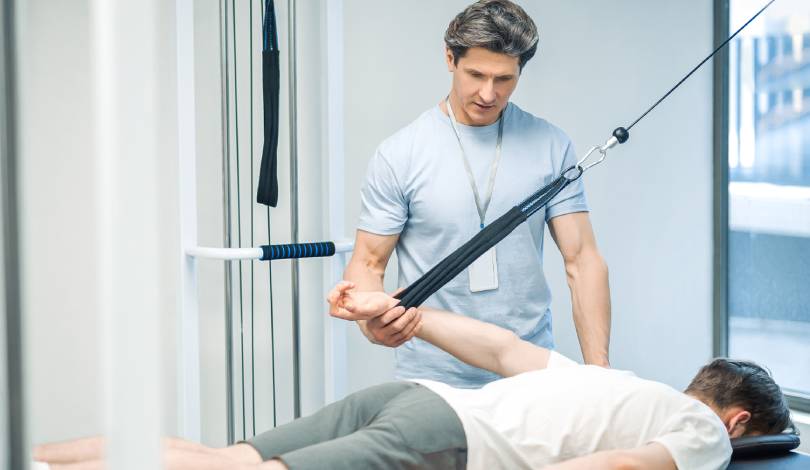Synopsis
Frozen shoulder, or adhesive capsulitis, is a condition marked by pain, stiffness, and restricted motion in the shoulder joint. It tends to develop gradually and can last for months or even years if left untreated. For many, it becomes a frustrating cycle of discomfort and immobility that interferes with daily tasks like dressing, driving, or lifting objects.
This blog dives into how physiotherapy for frozen shoulder offers an effective, non-surgical solution to restore movement and reduce pain. We’ll explore treatment strategies such as frozen shoulder physical therapy treatment, guided stretches, and manual therapy. Readers will learn how conditions like rotator cuff injury contribute to shoulder immobility and how frozen shoulder and physiotherapy go hand in hand in promoting recovery. We’ll also highlight how to find the right shoulder physio and what to expect in a session.
Whether you’re experiencing the early stages of stiffness or have been living with chronic discomfort, this blog will show how frozen shoulder treatment physiotherapy can help you regain control and strength—without surgery.
Table of Contents
What Is Frozen Shoulder?
Frozen shoulder, medically known as adhesive capsulitis, occurs when the shoulder capsule thickens and tightens around the joint, restricting its movement. It often begins with shoulder pain, followed by stiffness and significant limitation in the range of motion.
Most people with this condition struggle to perform basic movements and may find their daily quality of life compromised. Left untreated, it may take 1–3 years to resolve naturally. That’s why physiotherapy for frozen shoulder is critical—it shortens recovery time and improves functional outcomes.
Common Causes and Risk Factors
Frozen shoulder can develop spontaneously or as a result of:
- Previous shoulder injury or surgery
- Rotator cuff tears
- Immobilisation due to fracture or stroke
- Diabetes or thyroid issues
- Autoimmune conditions
Recognising symptoms early and seeking frozen shoulder physical therapy treatment can prevent long-term limitations.
Why Physiotherapy Works for Frozen Shoulder
Physiotherapy remains the gold standard for treating frozen shoulder without surgery. The goals of frozen shoulder treatment physiotherapy are to reduce pain, increase joint flexibility, and restore function.
Key benefits include:
- Pain relief through manual therapy
- Improved mobility through guided stretching
- Strengthening weakened shoulder muscles
- Preventing recurrence or worsening of stiffness
- Gradual return to everyday activities
The treatment evolves through stages as the shoulder improves, which is why frozen shoulder and physiotherapy must be tailored to each individual.
Key Techniques in Frozen Shoulder Physio Treatment
Physiotherapy follows a three-stage model: freezing, frozen, and thawing. The techniques used vary depending on the phase:
- Freezing Stage: Focus on pain management (TENS, cold packs, gentle stretches)
- Frozen Stage: Emphasis on passive and active range-of-motion exercises
- Thawing Stage: Advanced strengthening and function restoration
Techniques include:
- Pendulum swings and cross-body stretches
- Shoulder pulley exercises
- Joint mobilisation
- Capsular stretching
- Soft tissue massage
These approaches form the foundation of effective frozen shoulder physio treatment.
Understanding the Role of the Rotator Cuff
The rotator cuff—a group of four muscles—plays a crucial role in shoulder stability and movement. Injuries or inflammation here often precede or accompany frozen shoulder.
That’s why physiotherapy for rotator cuff injury is often integrated with frozen shoulder rehab. It helps reduce strain, support mobility, and avoid secondary injuries. Strengthening these muscles ensures better long-term outcomes.
How to Find the Right Shoulder Physio
Look for a physiotherapist with:
- Experience in shoulder joint disorders
- Training in manual therapy and joint mobilisation
- Access to advanced diagnostic tools
- Proven success with physio for shoulder pain
- A customised, stage-wise approach to treatment
A good shoulder physio not only treats symptoms but also empowers patients with strategies for self-management and long-term care.
Orthocure’s Approach to Shoulder Rehabilitation
At Orthocure Clinics, we believe in combining clinical expertise with personalised care. Our approach to treating frozen shoulder includes:
- Detailed musculoskeletal assessments
- Stage-based physio protocols
- MedX technology to analyse and track strength progress
- Continuous monitoring for pain and mobility
- Education and home exercise planning
We work with patients across all phases—from frozen to fully functional—ensuring that every step is supported and safe.
Conclusion
Frozen shoulder doesn’t need to be a long, painful journey. With the right care, it’s possible to restore full movement and eliminate pain—without injections or surgery.
Physiotherapy for frozen shoulder is effective, non-invasive, and backed by science. At Orthocure Clinics, we’re here to guide you every step of the way to reclaiming freedom in movement.
FAQs
Can physiotherapy fully cure frozen shoulder?
Yes, in many cases, physiotherapy can restore full shoulder mobility and eliminate pain without surgery. A personalised plan using joint mobilisation, stretching, and strengthening can accelerate recovery.
How long does it take to recover from frozen shoulder with physiotherapy?
Recovery depends on the stage of the condition. Most patients notice improvement in 6 to 12 weeks, with full recovery typically within 3 to 6 months when physiotherapy is done consistently.
What exercises are best for frozen shoulder?
Pendulum swings, cross-body stretches, and wall walks are highly effective in increasing shoulder mobility. These are commonly used in frozen shoulder physical therapy treatment and are adjusted as the condition improves.
Is physiotherapy painful for frozen shoulder patients?
Some discomfort is expected, especially during stretching phases, but physiotherapy should not be excessively painful. A qualified shoulder physio ensures exercises are safe, progressive, and tolerable.





